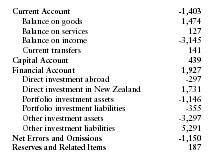New Zealand - Balance of payments
Since New Zealand's foreign trade depends on agricultural and livestock products, and since prices for these commodities are volatile, New Zealand's balance of payments may swing sharply from one year to the next. Generally, deficits outweighed surpluses during the 1950s and 1960s. Consistent surpluses were recorded between 1969 and 1973, when international reserves nearly quadrupled. However, a poor trade performance in 1974, largely attributable to increased oil import costs, contributed to a large current accounts deficit. Since then, New Zealand has continued to register payments deficits, which have been partially offset by compensatory financing, including overseas loans.
The US Central Intelligence Agency (CIA) reports that in 2001 the purchasing power parity of New Zealand's exports was $14.2 billion while imports totaled $12.5 billion resulting in a trade surplus of $1.7 billion.
The International Monetary Fund (IMF) reports that in 2001 New Zealand had exports of goods totaling $13.9 billion and imports totaling $12.5 billion. The services credit totaled $4.3 billion and debit $4.2 billion. The following table summarizes New Zealand's balance of payments as reported by the IMF for 2001 in millions of US dollars.

| Current Account | -1,403 |
| Balance on goods | 1,474 |
| Balance on services | 127 |
| Balance on income | -3,145 |
| Current transfers | 141 |
| Capital Account | 439 |
| Financial Account | 1,927 |
| Direct investment abroad | -297 |
| Direct investment in New Zealand | 1,731 |
| Portfolio investment assets | -1,146 |
| Portfolio investment liabilities | -355 |
| Other investment assets | -3,297 |
| Other investment liabilities | 5,291 |
| Net Errors and Omissions | -1,150 |
| Reserves and Related Items | 187 |
Comment about this article, ask questions, or add new information about this topic: